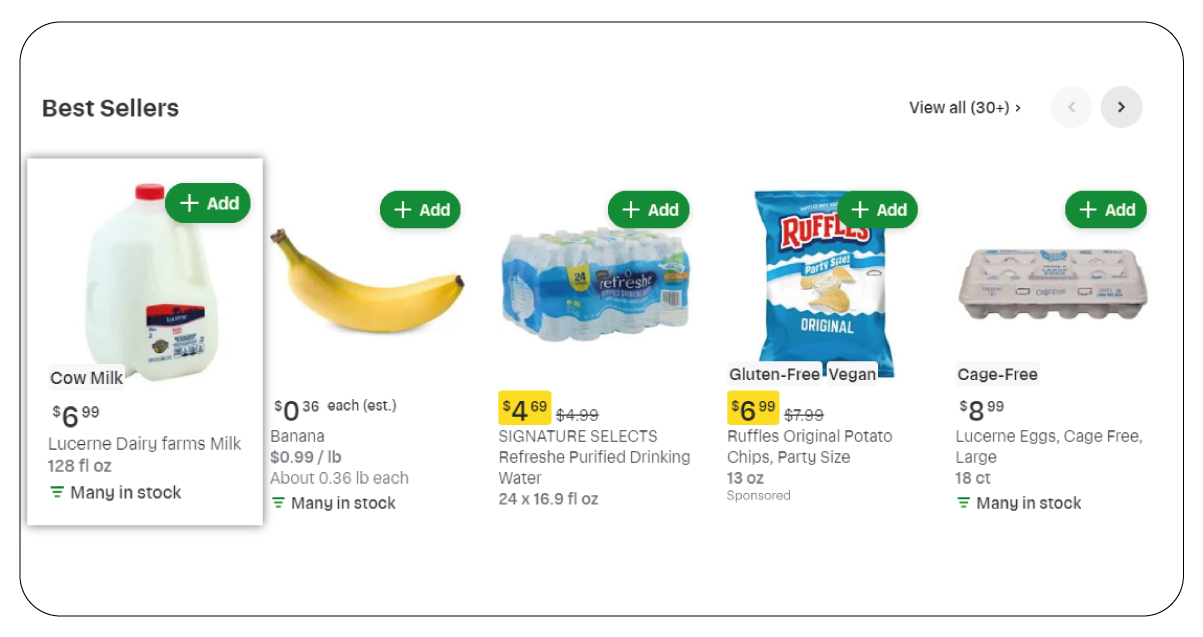
In the dynamic landscape of the grocery industry, harnessing the power of data is paramount for staying competitive. Grocery data scraping emerges as a transformative solution, allowing businesses to extract valuable information from diverse online sources. This process involves automated web scraping techniques to gather real-time data on product prices, availability, customer reviews, and market trends. By employing grocery data scraping services, retailers can understand the market comprehensively, enabling informed decision-making. It facilitates price optimization, inventory management, and the identification of emerging consumer preferences. The extracted data enhances strategic planning and enables retailers to use the InstaCart online grocery analysis dataset, which serves as a vital tool, providing actionable insights that drive efficiency, customer satisfaction, and overall business success in the ever-evolving grocery landscape.
About InstaCart

Instacart, founded in 2012, is a prominent online grocery delivery and pick-up service that has revolutionized how consumers shop for groceries. Operating in numerous cities across North America, Instacart connects users with personal shoppers who fulfill and deliver orders from local grocery stores. The platform offers various products, including groceries, household items, and prescription medications. Instacart has gained widespread popularity for its convenience and timely deliveries, providing users with a seamless and efficient way to access essential items without leaving the comfort of their homes. Scrape Instacart grocery delivery data to help analyze shopping trends, optimize delivery routes, and enhance customer experience by providing personalized recommendations based on individual preferences and purchasing history. This data-driven approach can also streamline inventory management, reduce operational costs, and ultimately contribute to the overall efficiency and success of the Instacart grocery delivery service. However, it's crucial to ensure compliance with Instacart's terms of service and privacy regulations while scraping and utilizing the data. Instacart grocery delivery data scraping services enable enhanced route optimization, trend analysis, and personalized recommendations, elevating efficiency in grocery delivery operations.
Instacart Grocery Dataset

Instacart grocery dataset enables businesses to gain unprecedented insights into consumer preferences and shopping behaviors, fostering data-driven decision-making. This rich repository empowers retailers to optimize inventory management, predict trends, and personalize marketing strategies. With detailed information on product popularity, regional demand variations, and customer demographics, companies can tailor their offerings to meet specific market demands. The dataset enhances supply chain efficiency, reducing waste and ensuring timely restocking. Moreover, businesses can leverage this Instacart dataset to implement targeted promotions, enhancing customer engagement and loyalty. Ultimately, the Instacart grocery dataset catalyzes innovation and strategic planning in the competitive retail landscape.
Significance of Grocery Dataset

Inventory Optimization: Businesses can use grocery datasets to analyze product demand patterns, helping optimize inventory levels. It ensures the stocking of popular items, reducing instances of stockouts or overstock.
Personalized Marketing: Scrape InstaCart grocery delivery data for personalized marketing strategies. Retailers can tailor promotions and discounts based on individual preferences, enhancing customer engagement and loyalty.
Supply Chain Efficiency: Businesses can streamline operations by understanding the flow of products through the supply chain. It leads to improved logistics, reduced wastage, and overall efficiency gains in the supply chain.
Trend Analysis: The dataset enables businesses to identify and capitalize on emerging trends. By analyzing purchasing behaviors, retailers can stay ahead of the curve, introducing new products or adjusting existing offerings to meet changing consumer preferences.
Customer Segmentation: Segmentation based on demographic and behavioral data using grocery data scraper allows businesses to target specific customer groups. It leads to more effective marketing campaigns and a better understanding of diverse consumer needs.
Predictive Analytics: Advanced analytics on grocery datasets enable predictive modeling. Retailers can forecast future demand, enabling proactive procurement, pricing, and marketing decision-making.
Competitive Intelligence: Businesses can compare their performance with competitors by analyzing market trends and customer preferences. This competitive intelligence is valuable for strategic planning and maintaining a competitive edge.
Operational Efficiency: Beyond inventory, grocery datasets can optimize other operational aspects, such as staffing and store layout. Understanding peak shopping times and popular product placements contributes to a more efficient and customer-friendly shopping experience.
Steps to Collect Instacart Grocery Datasets

Access Instacart API: To collect Instacart grocery datasets, developers can utilize the Instacart API (Application Programming Interface). It involves obtaining API access credentials by registering with Instacart's developer platform.
Define Data Requirements: Clearly define the specific data parameters needed for your analysis. It may include customer transactions, product details, order history, and user demographics. Ensure compliance with Instacart's terms of use during data collection.
Implement Data Scraping: Employ web scraping techniques to collect relevant data from Instacart's online platform. It involves creating scripts or programs that navigate the website, mimic user interactions, and extract the required information systematically.
Consider Legal and Ethical Aspects: Be mindful of legal and ethical considerations when collecting data from online platforms. Ensure compliance with Instacart's terms of service and respect user privacy. Unauthorized scraping or data collection may result in legal consequences.
Handle Rate Limiting and Throttling: Instacart may have rate limits to control the frequency of API requests. Implement measures to handle rate limiting and throttling to avoid being blocked or restricted during data collection.
Data Cleaning and Validation: Clean and validate the collected data to ensure accuracy and consistency. Handle incorrect information appropriately and verify that the dataset meets the defined requirements. This step is crucial for ensuring the reliability of subsequent analyses.
Conclusion: Analyzing Instacart grocery datasets opens a gateway to unprecedented business insights and opportunities. By harnessing information on consumer behaviors, product preferences, and market trends, companies can make informed decisions to optimize inventory, enhance marketing strategies, and improve overall operational efficiency. The datasets pave the way for personalized customer experiences, predictive analytics, and the identification of emerging trends. However, ethical considerations and adherence to data usage policies are paramount. As businesses navigate this valuable resource, they must balance innovation with responsibility, ensuring that data-driven decisions contribute positively to customer satisfaction and sustainable business growth.
Product Data Scrape operates with a foundation in ethical standards, offering services such as Competitor Price Monitoring and Mobile Apps Data Scraping. We guarantee clients exceptional and transparent services, catering to diverse needs on a global scale.




















.webp)




.webp)
.webp)
